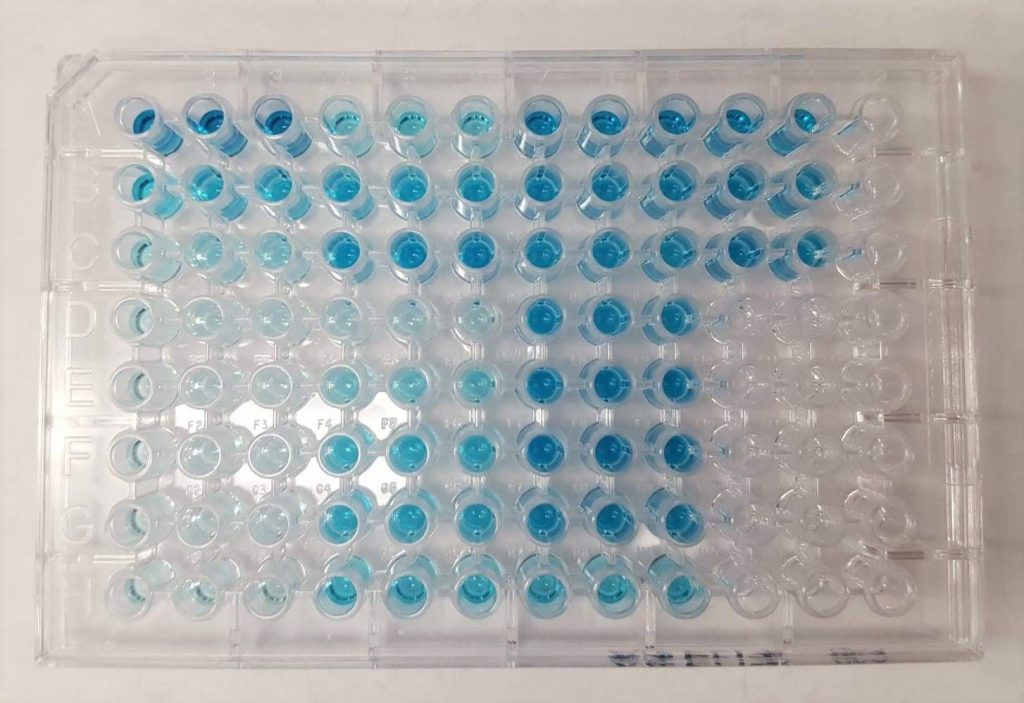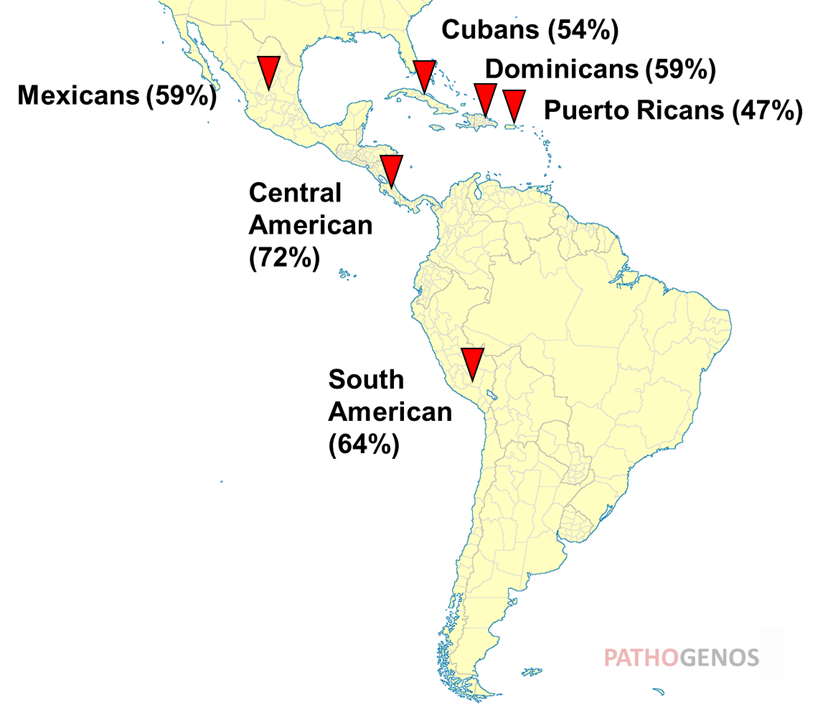Since 2020, we have battled the COVID-19 disease caused by the highly pathogenic virus SARS-CoV-2 belonging to the constantly evolving SARS virus family.
Although it has completely changed our way of life, particularly affecting those of Black, Hispanic, and Native ethnic backgrounds in the U.S., it is recent.
There is a bacterial pathogen that has been infecting the Hispanic/Latino community for much longer.
I talk about Helicobacter Pylori ( H. pylori), previously named Campylobacter Pylori upon its discovery by Professors Marshall and Dr Warren in 1982 ( Figure 1).

Why we care
H. pylori usually lives in the stomach and its chronic, or continued, infection is the strongest risk for noncardia gastric cancers (90% of gastric cancers).
This disease has an incidence rate of 5.9 per 100,000 Hispanics compared to the low incidence rate of cardia tumors (tumors in the top of the stomach) not associated with H. pylori infection.
H. pylori is also the most frequent cause of chronic gastritis, leading to gastric and duodenal peptic ulcer disease, gastric cancer, and gastric mucosa-associated lymphoid tissue lymphoma.
In upcoming blogs, I will discuss the basic biology we know about this bacterium and how research has consistently shown that Hispanic/ Latinos are one of the ethnic backgrounds most affected by it.
Here, I talk about a recent scientific paper published in the Journal of Clinical Gastroenterology and Hepatology in 2022 (impact factor of 13.57) by Sabrina H. Tsang and colleagues at the National Cancer Institute in Maryland.
Their data show that there is a difference in H. pylori seroprevalence, or frequency of infection, based on Hispanic/Latino cultural background and multiple factors associate with the disease.
Reason for the study

Because of the high propensity of Hispanics/Latinos to be infected with H.pylori, the questions the scientists asked were:
- Are there differences in how prevalent Helicobacter Pylori (H. Pylori) infection is based on Latino cultural background, including those from the Dominican Republic, Central America, Cuba, Mexico, Puerto Rico, and South America?
- and if so, what factors are associated with H. pylori infection ?
Patient characteristics
To answer this question, the investigators analyzed data and blood samples from the Hispanic Community Health Study/Study of Latinos (HCHS/SOL) cohort.
This is basically a population-based sample from the years 2008-2011 with a total of 16,144 Hispanics/Latinos aged 18-74 years from four U.S. communities: Bronx in New York City, Chicago, Miami, and San Diego.
When samples were obtained, a questionnaire was done to get plenty of information: the demographics, medical history, occupational exposures, smoking and alcohol habits, oral/dental health, physical activity, and 24 h dietary recall.
In addition to this, clinical assessments like dental exams, an acculturation scale, and blood samples at fasting were collected.
The science
All about antibodies (Abs)
To connect this data with frequency of H. pylori infection, the investigators did some experimenting with the blood samples collected.
Basically, if the participant was infected with H. pylori, her immune system will kick in.
After a few days of infection, a type of cell that is part of our more specific or adaptive immune system, called a B cell, will mature and produce specific guns ( or antibodies) to kill H. pylori bacteria.

These antibodies against specific pathogens can be analyzed and their amount in the blood, specifically blood plasma, can be used as a measure of pathogen infectivity.
In this study, the investigators assessed the levels of these guns or antibodies in each patient as a measure of H.pylori infection frequency or seroprevalence.
Because the levels of these antibodies or guns usually go down after one year of the body completely getting rid of H. pylori bacteria in the patient, the researchers in this study believe H pylori seropositivity mainly reflect current infection at the time of blood collection.
Scientifically speaking, they measured the levels of anti-H pylori immunoglobulin G antibodies using baseline citrated plasma.
Measuring Abs using ELISA
How they measured the levels of these antibody was by using a very established immunology method called an ELISA. Although it seems like the name of a person, ELISA actually stands for Enzyme-Linked Immunosorbent Assay.

It uses principles the field of immunology have discovered about antibodies (the guns) and their specific antigen (the targets) along with proteins linked with shiny substrate to be able to visibly see change in color based on the levels of antibody in the plasma.
This change in color can be quantified to assess how much antibody or cell are producing against a pathogen, this case H pylori, and this antibody levels then tell us whether the patient is infected or not.
When researchers mention that the definition of seropositivity is titers > 30 EUY, this is what they mean:
Titer is a lab test used to measure the presence and amount of antibodies in blood. The unit EIU stands for Enzyme Immunoassay Units. A titer of 30 EIU means the concentration of antibodies in the blood is 30 times higher than the concentration of antibodies in a standard sample.
To note is that all laboratory researchers were blinded to any participant characteristics
Analyzing the data with statistics
To connect the dots, the researchers performed multiple statistical models and regressions, including statistic adjustment.
Statistic adjustment is applying math where there are multiple variables(for example, variable A, B, and C) to remove the influence of A when looking at similarities and trend of B and C. To achieve this, statistical modeling is used to make an imaginary model in which we can remove the variable A. These are important inferential tools. To make adjustments, the question of which factor is of primary interest and which should be imagined away need to be clearly presented in the data analysis.
Results
Who participated?
There were 52% females and 48% males, were 43% were 25-44 years old, 23% born in the US, and with a median age at immigration of 25 years old.
The Latino cultural background of this cohort included 37% Mexicans, 20% Cuban, 16% Puerto Rican , 10% Dominican, 7% Central American, and 5% South American residing in either the Bronx, Chicago, Miami, or San Diego area.
The education level of the participants included less than high school (32%), high school or equivalent (28%), and greater than high school or equivalent ( 39%).
In terms of money, the majority had an annual income between $10,000-40,000.
Most participants had low acculturation scores (73%) to have an idea of how much they have assimilated to the American culture.
Lastly, most (59%) were Hepatitis A positive, which have been associated in previous scientific studies with H. pylori infection.
What was the frequency of H. pylori infection?
Of all the participants, 57% tested seropositive for H. pylori infection. To note is that gender did not affect this percentage.
However, when researchers looked at age, H. pylori seropositivity increased with age up to 54 years old and then decreased regardless of cultural background.
When researchers looked at cultural background while adjusting for similar age, H. pylori infection among Latino cultural background showed an interesting difference(%).
Shown below are the cultural background differences from highest to lowest H. pylori seroprevalence ( Figure 2)

In addition, frequency of H. pylori infection was also higher for non-US born Hispanics/Latinos (62%) compared to those born in the US (38%).
What factors determined higher levels of H. Pylori infectivity?
When adjusting or “getting rid/removing influence” of age-,sex-, and background differences, lower socioeconomic status was associated with higher H. pylori seropositivity
You can find all factors found to be associated and NOT associated with high H. pylori frequency in the figure below (Figure 3).

What this means
Multiple studies show how non-Hispanic whites were observed to have lowest H. pylori seroprevelance (21%) in the NHANES (Health and Nutritional Status of Adults and Children in the US) public data of 1999-2000.
Previous studies did not focus on whether there is a difference in frequency of H. pylori infection based on different Hispanics/Latino cultural background. That was one of the main objectives of this paper along with seeing trends that associate with infection.
In terms of the association seen with increasing age, the authors mention this trend is likely due to a birth cohort effect decreasing bacterial exposure in recent generation in addition to the role of immunoscenescence in wanning immunity against H pylori.
In the case of the association seen with anemia/iron deficiency., there has been multiple studies showing how H pylori uses iron to regulate its virulence genes so competes with the host for this essential metal.
In terms of Hepatitis A infection and its association with H. pylori, a main route of transmission of hepatitis A is fecal-oral akin to H pylori which can be isolated from dental plaque, saliva, and feces.
For reasons explaining teeth association, tooth loss is a proxy for socioeconomic status and positively associated with gastric cancer risk. Teeth loss may also affect oral microbiome or mouth microbes.
Limitations and strengths of this study
Some of the limitations of this study is adding all cultural backgrounds/ countries from Central America and South America together instead of assessing them independently.
The authors also lacked data on antibiotic use on HCHS/SOL participants, which would be interesting to know H. pylori resistance and how this affects the observed results based on cultural background. After all, H. pylori has been shown to exhibit antibiotic resistance with regional differences in China, for example.
Another interesting note is that the study uses patient data collected from 2008-2011, but this article was published in 2022. Therefore, it may not indicate recent percent seroprevalence based on Latino cultural background.
However, when focusing on the strength of this study, this was population-based study with largest dataset on Hispanics/Latinos using a centralized ELISA method. Importantly, it demonstrated the high vulnerability of Hispanics/Latinos to H. Pylori.
Implications for the U.S. population
Hispanic/Latinos made up 19% (62.1 million) of US population in 2021 and have become the largest racial population in California and Texas, currently playing a major role in driving U.S population growth.
When looking further as to the cultural background they come from, the OMHs reports that in 2020, Mexicans ranked as the largest at 61.6 % followed by Puerto Ricans (9.6 %), Central Americans (9.3 %), South Americans (6.4 %), Other Hispanic/Latino (including Spanish) (5.8 %), and Cuban (3.9 %). In terms of states with largest Hispanic populations, these include Arizona, California, Colorado, Florida, Illinois, Nevada, New Jersey, New Mexico, New York, and Texas.
Yet, I will end this with a direct quote from the authors in their study:
This study highlights the lack of progress and the importance of this bacterial infection in the U.S. and suggests opportunities for prevention measures in the Hispanic/Latino population.
Sabrina H. Tsang et al.
But what do you think? Share your thoughts below!


Hey there I am so glad I found your website, I really found you by error, while I was researching on Aol for something else, Anyhow I am here now and
would just like to say thanks a lot for a fantastic post
and a all round enjoyable blog (I also love the theme/design), I don’t have time to browse it all at the minute but I have bookmarked it
and also included your RSS feeds, so when I have time I will be back to
read more, Please do keep up the awesome work.